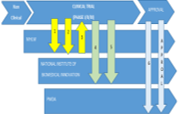Abstract
Due to various reasons, the pharmaceutical industries growth has slowed in recent years. The current economic situation has therefore shifted the pharmaceutical companies ' focus from essential medicine to the new business model called "orphan drugs”. Healthcare standards are among the worlds highest in Japan. For about 99 percent of its citizens, the Japanese government provides health insurance. Rare diseases fall under ‘intractable diseases (Nanbyo)' in Japan. Japan regulatory body PMDA is providing all guidance and instructions on orphan drugs. In Australia, Australia’s regulatory body providing all guidance on orphan drugs to the health care system. To be named an orphan drug in Australia, the pharmaceutical company that developed the medication will show to the Orphan Drug Program that the drug is not commercially viable for such a small population of patients. Often, the Orphan Drug System reduces the amount of time it usually takes for the TGA to test a drug. Once a drug is approved as an orphan drug, it is easier for the drug to become available, and it can be obtained through the Life Saving Drugs Program in certain situations. This review study provides comparative study of guidelines for orphan drug and rare diseases regulations in Japan and Australia.
Full text article
Authors

This work is licensed under a Creative Commons Attribution-NonCommercial-NoDerivatives 4.0 International License.

